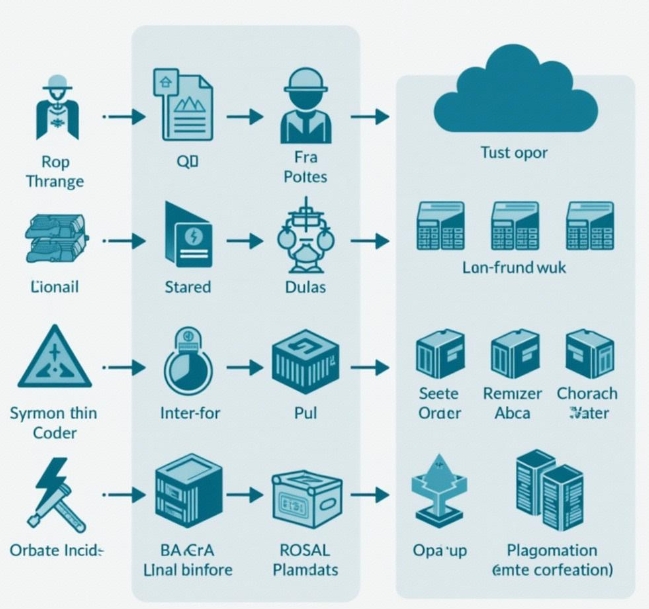Inventory Management and Order Processing in E-commerce Development
- latest articles
- 1.DApp Development & Customization: Merging Diverse Market Needs with User Experience 2.Analysis of the Core Technical System in DApp Project Development 3.How to achieve cross-chain interoperability in Web3 projects? 4.How does the tokenization of points reconstruct the e-commerce ecosystem? 5.How to Set and Track Data Metrics for a Points Mall? 6.What is DApp Development? Core Concepts and Technical Analysis 7.Inventory of commonly used Web3 development tools and usage tips 8.Development of a Distribution System Integrated with Social E-commerce 9.Six Key Steps for Businesses to Build a Points Mall System 10.What is DApp Development? A Comprehensive Guide from Concept to Implementation
- Popular Articles
- 1.Future Trends and Technology Predictions for APP Development in 2025 2.Analysis of the DeFi Ecosystem: How Developers Can Participate in Decentralized Finance Innovation 3.From Zero to One: How PI Mall Revolutionizes the Traditional E-commerce Model 4.DAPP Development | Best Practices for Professional Customization and Rapid Launch 5.Recommended by the Web3 developer community: the most noteworthy forums and resources 6.From Cloud Computing to Computing Power Leasing: Building a Flexible and Scalable Computing Resource Platform 7.How to Develop a Successful Douyin Mini Program: Technical Architecture and Best Practices 8.Shared Bike System APP: The Convenient Choice in the Era of Smart Travel 9.How to Create a Successful Dating App: From Needs Analysis to User Experience Design 10.From Design to Development: The Complete Process of Bringing an APP Idea to Life
In the rapid development of modern e-commerce, the design and development of mall systems have become a crucial aspect for the successful operation of a business. Inventory management and order processing, as two of the most critical modules, play a decisive role in the efficiency of the mall, customer experience, cost control, and other aspects. This article will explore inventory management and order processing in mall development, analyzing their design principles, technical architecture, implementation methods, and the challenges faced, aiming to provide valuable insights for developers and operational staff.
I. Inventory Management in Mall Development
Inventory management refers to the systematic management of the quantity, types, procurement, and sales of goods stored by merchants. An effective inventory management system not only improves operational efficiency but also helps merchants reduce excessive inventory backlog, lower capital occupancy rates, enhance capital turnover efficiency, and ultimately increase overall profits.
1.1 Basic Functions of Inventory Management
The inventory management module in mall development generally includes the following core functions:
Inventory Tracking: Real-time tracking of inventory changes, including goods receipt, dispatch, returns, etc. This function is crucial for ensuring the accuracy of inventory information.
Inventory Alerts: When inventory levels fall below the set minimum threshold, the system automatically sends alerts or notifications to help merchants replenish stock in a timely manner, preventing sales losses due to stockouts.
Inventory Transfers: In a multi-warehouse environment, the mall system needs to support the transfer and relocation of goods inventory to optimize inventory allocation and maximize the utilization of inventory resources.
Inventory Statistics and Analysis: Through data analysis, merchants can understand sales trends of different products, identify slow-moving and fast-moving items, and provide a basis for future procurement decisions.
1.2 Technical Architecture of Inventory Management
At the technical implementation level, inventory management needs to support high concurrency, high accuracy, and high availability. Typically, mall systems adopt the following architecture to achieve inventory management functions:
Distributed Database: Due to the surge in mall orders, a single database often cannot meet the demands of high-concurrency requests. A distributed database system can disperse inventory data across multiple nodes, ensuring high availability and load balancing.
Caching Technology: To improve the speed of inventory queries, mall systems often use caching technologies like Redis to store inventory information in memory, reducing the pressure on database access.
Real-Time Synchronization: Changes in inventory data need to be synchronized in real-time across all processes, especially on large-scale e-commerce platforms. Message queues (such as Kafka, RabbitMQ) can be used to achieve real-time synchronization of inventory data, ensuring data consistency across all processes.
1.3 Challenges and Solutions in Inventory Management
During mall development, inventory management faces numerous challenges, especially as the platform scales, where issues become more prominent.
Inventory Data Inconsistency: Inventory data across multiple systems or services may become out of sync, leading to inaccurate inventory information and affecting user experience. Solutions include using event-driven mechanisms, distributed locks, and other technologies to ensure the atomicity and consistency of inventory operations.
Complex Return Processing: Accurately and promptly updating inventory after customer returns is a challenge. Solutions can involve intelligent return management systems combined with automated inventory update mechanisms to ensure the accurate reflection of each product's status.
Inventory Optimization Issues: In some cases, both overstocking and understocking can impact a merchant's profits. The mall system should integrate historical sales data and use predictive analysis, automatic replenishment strategies, and other methods to optimize inventory allocation.
II. Order Processing in Mall Development
Order processing is another extremely important function in the mall system. It not only relates to the user's shopping experience but also directly affects the merchant's logistics costs and user satisfaction. Therefore, designing an efficient, flexible, and scalable order processing system is a key task in mall development.
2.1 Basic Process of Order Processing
The order processing flow in a mall system typically includes the following main steps:
Order Creation: After the user completes product selection and payment, the system generates a new order and records relevant information such as products, quantities, user details, and payment methods.
Order Confirmation: After the order is generated, the system confirms inventory to ensure the purchased product quantities are sufficient. If stock is insufficient, the system will notify the user and provide solutions.
Payment Processing: The mall system needs to integrate with third-party payment platforms (such as Alipay, WeChat Pay, etc.) to complete the payment process. Upon successful payment, the system must promptly update the order status and trigger subsequent shipping operations.
Order Fulfillment: After payment confirmation, the merchant packs and ships the goods based on the user's delivery address. Shipping information needs to be updated in real-time in the system for users to track logistics status.
After-Sales Service: After the order is completed, users may have needs such as returns, exchanges, or refunds. The mall system must handle these after-sales requests and update the order status accordingly.
2.2 Technical Architecture of Order Processing
The efficiency of order processing is crucial for the stability of the mall system. To this end, the commonly used technical architecture in mall development includes the following aspects:
Microservices Architecture: To enhance system flexibility and scalability, many mall systems adopt a microservices architecture, breaking down order processing into multiple independent service modules, such as order creation, payment, and fulfillment services. This architecture can effectively handle high-concurrency scenarios and allow independent scaling of each module.
Asynchronous Processing: Operations like payment and shipping often take time. Using asynchronous processing can prevent system blockages. For example, after an order payment, payment information is passed via message queues to inventory and fulfillment systems for processing, avoiding blockages in the order processing flow.
Data Consistency Assurance: Ensuring data consistency in distributed systems is a challenge. Distributed transactions, compensation mechanisms, and other methods can be used to ensure the accuracy and consistency of orders.
2.3 Challenges and Solutions in Order Processing
Order processing also faces many challenges, especially when order volumes surge. Ensuring system stability and efficient operation becomes a key issue in development.
High Concurrency Pressure: When order volumes surge, the mall system may face excessive database pressure. Solutions include using database read-write separation, data sharding, and other technologies to handle high-concurrency scenarios.
Order Status Management: Maintaining consistency and correctness of order status when transferring order information between multiple systems is a design challenge. State machine models or event-driven designs can be used to manage the order lifecycle, ensuring status consistency across all processes.
Multi-Channel Payment Issues: With the diversification of payment methods, handling orders from different payment channels and ensuring smooth integration with inventory, fulfillment, and other processes is another challenge that the order processing system must address.
2.4 How to Optimize the Order Processing Flow
To improve the efficiency of order processing and user experience, mall developers can optimize from the following aspects:
Automated Processing: Use automated tools to process orders, such as automatically generating shipping documents after payment confirmation, reducing the time and cost of manual intervention.
Multi-Channel Support: Support different payment methods and logistics options to enhance user experience and increase the flexibility of order processing.
Real-Time Notification System: Use SMS, email, app push notifications, and other methods to inform users of order status in real-time, allowing customers to stay updated on order progress and improving customer satisfaction.
III. Summary
Inventory management and order processing in mall development are core components of the entire e-commerce system. Efficient inventory management not only improves capital utilization and reduces inventory backlog but also ensures timely supply of goods, preventing stockouts. The order processing system directly determines the user's shopping experience, and an optimized order processing flow can reduce delivery times and enhance after-sales service quality. Faced with the increasingly complex demands of modern e-commerce platforms, developers need to continuously explore new technologies and architectures to address these challenges and improve the overall efficiency of the system through meticulous design.
-

How does the tokenization of points reconstruct the e-commerce ecosystem?
With the continuous advancement of internet technology and the gradual prolifera···
-

How to Set and Track Data Metrics for a Points Mall?
With the rapid development of the e-commerce industry, points malls, as a common···
-

Development of a Distribution System Integrated with Social E-commerce
With the rapid development of internet technology, the e-commerce industry has e···

 Blockchain
Blockchain












